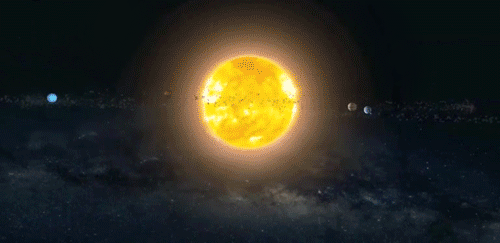spaceplasma:How Do the Planets Stay in Orbit?The manner in which stars and planets form is not well
spaceplasma:How Do the Planets Stay in Orbit?The manner in which stars and planets form is not well understood, but according to the most popular hypothesis (nebular) of cosmic evolution; all planetary and stellar systems are born from the gravitational collapse of giant interstellar clouds.Solar system formation happens when part of a molecular cloud begins to contract under its own gravitational force. As gravity forces the dense core to become smaller, it spins faster and faster –due to the conservation of angular momentum. The collisions between particles in the molecular cloud gradually reduce random motions, only circular orbits remain and as a result the contracting cloud flattens into a spinning pancake shape (protoplanetary disk) with a bulge at the center (protostar). All orbital motion of the planets – including the spin, is due to this original angular momentum.The reason why the planets stay in their orbits is because the force of gravity between the planet and the Sun provides a centripetal force: the Sun pulls the planets in orbit around it with the force of gravity that is strong enough to divert the planets from a straight line path. At the same time, the angular momentum of the planets gives them a tangential velocity that prevents the Sun from pulling them in. Isaac Newton’s law of universal gravitation states that everything with mass generates gravity, and like all objects with mass, planets have a tendency to resist changes to their speed and direction. This tendency is called inertia.The combination of the centripetal acceleration that gravity provides and the tangential velocity that inertia provides is what keeps the planets in stable orbit.Newton’s laws of motion and law of gravity explain Kepler’s three laws of orbital motion which govern the orbits of planets, satellites, comets, asteroids, stars and even galaxies. Kepler’s laws apply to any object, orbiting another object, under the influence of gravity. So, what are these universal laws?Kepler’s first of three laws states that each planet moves in an elliptical orbit, with the Sun at one focus (The Law of Ellipses):Kepler’s second law: the orbital speed changes regularly as the distance from the Sun changes, meaning that when the planet is far away from the Sun, it does not move as fast as when it is close to the Sun (The Law of Areas). This implied that whatever force was moving the planet weakened with distance, and this led to the realization of what became Kepler’s first law: that the planets move in an ellipse:Kepler’s third law (The Law of Harmonies) can be derived from Newton’s laws of motion and the universal law of gravitation. The third law shows that orbital period increases with orbital radius:Kepler’s laws clearly show the effects of gravity on orbital motion. Using these laws and calculus (which Newton invented), Newton was able to prove that the planets orbit the Sun because they are influenced by its gravity. -- source link
Tumblr Blog : spaceplasma.tumblr.com
#astrophysics#johannes kepler#good reads
